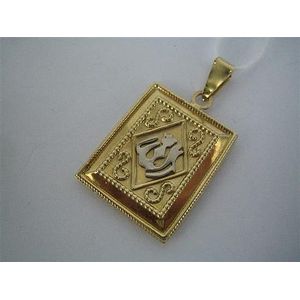Enamel and Pearl Verge Pendant Watch
Gide et Blondet Fils. A gold, enamel and seed pearl verge pendant watch Continental circa 1810, gilt full plate movement, verge fusee escapement, pierced and engraved balance cock, white enamel dial, Arabic numerals, outer minute track, blued steel Breguet hands, diamond-shaped case applied with blue guilloche enamel decoration within half-pearl borders, dial signed, 30 x 47 mm. Accompanied by a key.
You must be a subscriber, and be logged in to view price and dealer details.
Subscribe Now to view actual auction price for this item
When you subscribe, you have the option of setting the currency in which to display prices to $Au, $US, $NZ or Stg.
This item has been sold, and the description, image and price are for reference purposes only.
- Circa - A Latin term meaning 'about', often used in the antique trade to give an approximate date for the piece, usually considered to be five years on either side of the circa year. Thus, circa 1900 means the piece was made about 1900, probably between 1895 and 1905. The expression is sometimes abbreviated to c.1900.
- Movement - The technical name for the workings of a clock or watch, and does not include the dial or case.
- Fusee - The fusee movement was used in clocks and pocket watches from the mid 17th century. The fusee is a cone shaped drum within the works that is linked to the barrel of the spring, usually by a length of chain.
As the mainspring loses its tension over time, the cone shaped barrel compensates for this by increasing the tension, by pulling the mainspring tighter, thus ensuring the time remains constant.
Use of the fusee in clocks was superseded by the "going barrel" in the mid 19th century and for pocket watches at the beginning of the 19th century.
The fusee continued to be used in marine chronometers until the 1970s. - Guilloche - A form of classical decoration consisting of a repeating ornament of interlacing curved bands, sometimes forming circles, and further decorated with rosettes or other flower forms.
The name is derived from the inventor, French engineer Guillot, who invented a mechanical method of inscribing fine repeating patterns on to metallic surfaces.
On enamelled items with guilloche decoration, the surface is firstly engraved with the repeating pattern, and then covered with several layers of enamel, each of which is fired.
Where the item has not been enamelled the form of decoration is usually called "engine turned".
This item has been included into following indexes:
Visually similar items

Vfa: 1938 Victorian football Association membership badge, numbered '121' on reverse.
Sold by
in
for
You can display prices in $Au, $US, $NZ or Stg.

An 18ct gold pendant. Weight 3.5g.
Sold by
in
for
You can display prices in $Au, $US, $NZ or Stg.

An Edwardian style garnet and pearl pendant, central garnet surrounded by seed pearls with a freshwater pearl drop, 9ct gold length 50 mm.
Sold by
in
for
You can display prices in $Au, $US, $NZ or Stg.

Vintage miniature silver purse, with marcasite and engraved decoration. Length 3.5 cm
Sold by
in
for
You can display prices in $Au, $US, $NZ or Stg.
